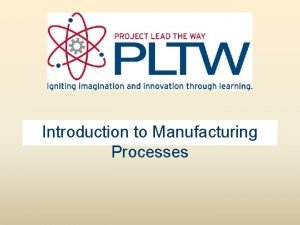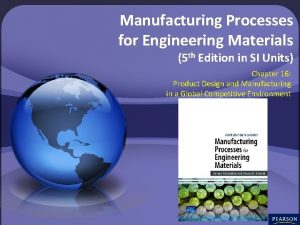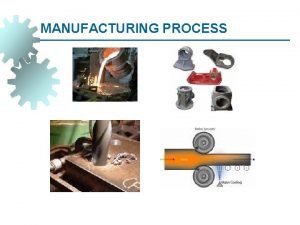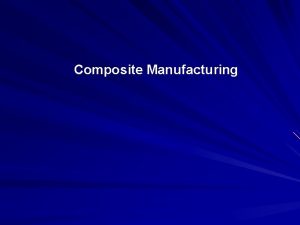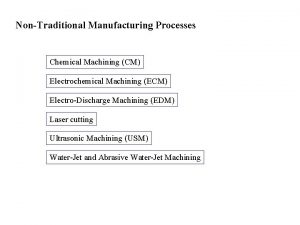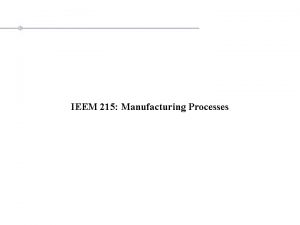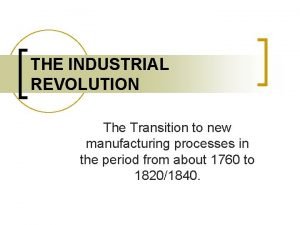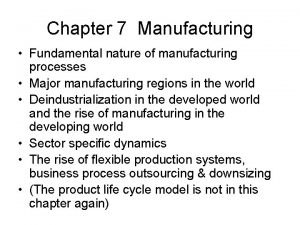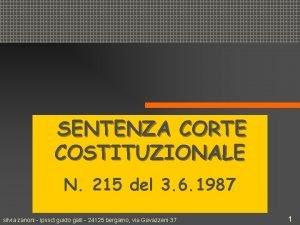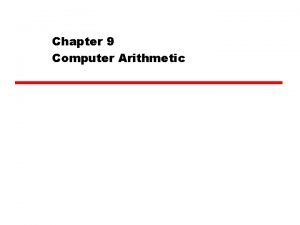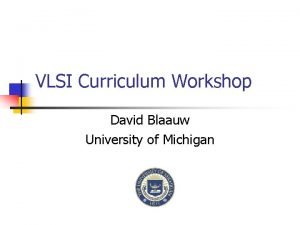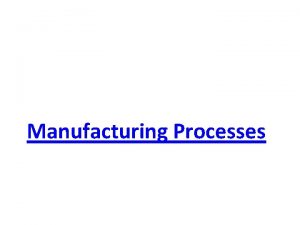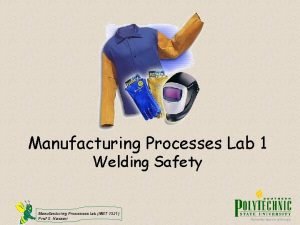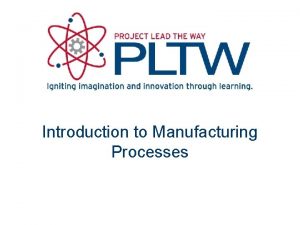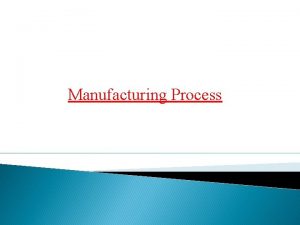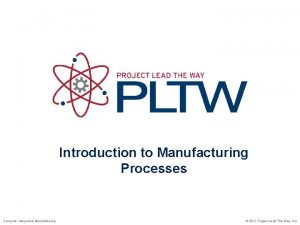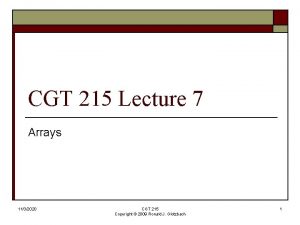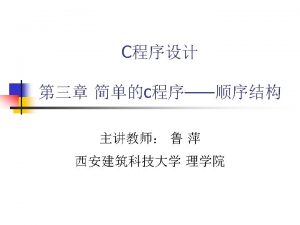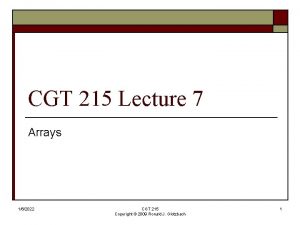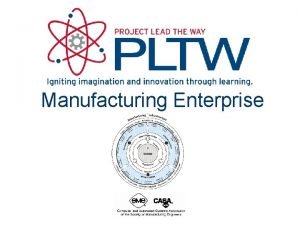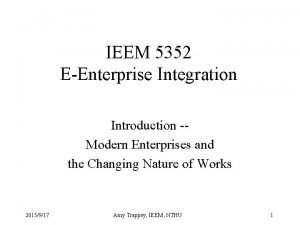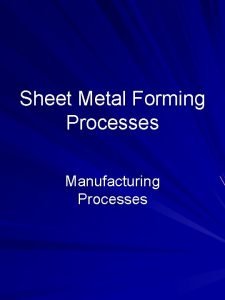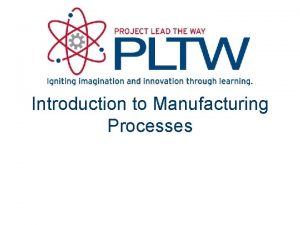IEEM 215 Manufacturing Processes Introduction and Agenda Outcomes

















![Shear strength and Tensile strength [approximate relation between shear and tensile strengths] Ultimate Tensile Shear strength and Tensile strength [approximate relation between shear and tensile strengths] Ultimate Tensile](https://slidetodoc.com/presentation_image_h/b1d5c08c7cabd7fddef77633422b4b0e/image-18.jpg)






- Slides: 24

IEEM 215: Manufacturing Processes

Introduction and Agenda Outcome(s) Materials Properties - helps to determine how to make things with it - helps to determine the processing conditions - helps and constrains process optimization 1. 0 1. 1 Processes - forming, cutting, non-traditional, joining, surface treatments, electronics components, … 2. 0 2. 1 7. 0 Process Planning 4. 0 CNC programming 6. 0, 6. 1 Process Evaluation and Quality control 5. 0, 8. 1 Process Economics and Optimization 5. 0 Product design and Fabrication 9. 0 3. 1

Motivation (1) A bottle of Watson’s water (~HK$6) Four components (bottle, cap, label, water) - How are each of these manufactured? - What does the equipment cost?

Motivation (2) Stapler (~HK$ 45) Approx. 15 components - How do we select the best material for each component? - How are each of these manufactured? Car: ~ 15, 000 parts; Boeing 747 plane: ~6 million parts Intel core 2 duo processor: 65 nm feature size, 291 million transistors

Materials Ferrous metals: carbon-, alloy-, stainless-, tool-and-die steels Non-ferrous metals: aluminum, magnesium, copper, nickel, titanium, superalloys, refractory metals, beryllium, zirconium, low-melting alloys, gold, silver, platinum, … Plastics: thermoplastics (acrylic, nylon, polyethylene, ABS, …) thermosets (epoxies, Polymides, Phenolics, …) elastomers (rubbers, silicones, polyurethanes, …) Ceramics, Glasses, Graphite, Diamond, Cubic Boron Nitride Composites: reinforced plastics, metal-, ceramic matrix composites Nanomaterials, shape-memory alloys, superconductors, …

Properties of materials Mechanical properties of materials Strength, Toughness, Hardness, Ductility, Elasticity, Fatigue and Creep Physical properties Density, Specific heat, Melting and boiling point, Thermal expansion and conductivity, Electrical and magnetic properties Chemical properties Oxidation, Corrosion, Flammability, Toxicity, …

Mechanical properties: Stress analysis stress = Force/Area Why do we need stress/strain (not just force, elongation) ? F 3 Tension F 2 F 1 sy Compression tyx txy tyz tzy Shear tzx sx txz sz Tensile, compressive and shear stresses Stresses in an infinitesimal element of a beam

Stress Analysis: Principal directions in 2 D case sy s tyx txy sx sx sx f t txy x tyx sy sy - principal directions are orthogonal to each other - 0 shear stress along PDs

Stress Analysis: Principal shear stress in 2 D case sy s tyx txy sx sx sx f t txy x tyx sy sy

Failure in Tension, Young’s modulus and Tensile strength Engineering stress = P/Ao Engineering strain = e = (L – Lo)/Lo = d/Lo

Failure in Tension, Young’s modulus and Tensile strength. . Original Final Necking Fracture

Failure in Tension, Young’s modulus and Tensile strength… In the linear elastic range: Hooke’s law: s = E e or, E = s/e E: Young’s modulus

Elastic recovery after plastic deformation

True Stress, True Strain, and Toughness Final Engg stress and strain are “gross” measures: Necking Fracture s = F/A => s is the average stress ≠ local stress e = d/Lo => e is average strain Toughness = energy used to fracture = area under true stress-strain curve true stress P/A engg stress P/Ao fracture engg strain d/Lo true strain ln(L/Lo)

Ductility Measures how much the material can be stretched before fracture Ductility = 100 x (Lf – Lo)/Lo High ductility: platinum, steel, copper Good ductility: aluminum Low ductility (brittle): chalk, glass, graphite - Walkman headphone wires: Al or Cu?

Hardness resistance to plastic deformation by indentation

Shear stress and Strain: the torsion test T L L T D g g T T C d q C’ Angle of twist: q = TL/GJ Shear stress: t = Tr/J Maximum shear stress = tmax = TR/J Shear strain = g = rq/L t=Gg T = torque, J = polar moment of inertia J = r 2 d. A Cylindrical shell: J = p( D 4 -d 4)/32 G: Modulus of rigidity
![Shear strength and Tensile strength approximate relation between shear and tensile strengths Ultimate Tensile Shear strength and Tensile strength [approximate relation between shear and tensile strengths] Ultimate Tensile](https://slidetodoc.com/presentation_image_h/b1d5c08c7cabd7fddef77633422b4b0e/image-18.jpg)
Shear strength and Tensile strength [approximate relation between shear and tensile strengths] Ultimate Tensile Strength = Su Ultimate Shear Strength = Ssu Tensile Yield Strength = Syp Shear yield point = Ssyp Material Tensile-Relation Yield-Relation Wrought Steel & alloy steel Ssu ≈ 0. 75 x Su Ssyp = Approx 0, 58 x Syp Ductile Iron Ssu ≈ 0. 90 x Su Ssyp = Approx 0, 75 x Syp Cast Iron Ssu ≈ 1. 3 x Su - Copper & alloys Ssu ≈ [0. 6 -0. 9] x Su - Aluminum & alloys Ssu ≈ 0. 65 x. Su Ssyp = Approx 0, 55 x Syp References: Machine design Theory and Practice. A. D. Deutschman, W. A Michels & C. E. Wilson. . Mac. Millan Publishing 1975.

Fatigue Fracture/failure of a material subjected cyclic stresses S-N curve for compressive loading

Failure under impact Application: Drop forging Testing for Impact Strength

Strain Hardening - Metals microstructure: crystal-grains - Under plastic strain, grains slipping along boundaries - Locking up of grains => increase in strength - We can see this in the true-stress-strain curve also Applications: - Cold rolling, forging: part is stronger than casting

Residual stresses Internal stresses remaining in material after it is processed Causes: - Forging, drawing, …: removal of external forces - Casting: varying rate of solidification, thermal contraction Problem: warping when machined, creep Releasing residual stresses: annealing

Physical Properties Property Application (e. g. ) Density, r = mass/volume Drop forging, hammering Specific heat Coolant in machining Thermal conductivity Cutting titanium Coeff of linear thermal expansion, a = DL/(L DT) Compensation in Casting, … Melting point Brazing, Casting, … Electrical conductivity EDM, ECM, Plating Magnetic properties Magnetic chucking

Summary Materials have different physical, chemical, electrical properties Knowledge of materials’ properties is required to Select appropriate material for design requirement Select appropriate manufacturing process Optimize processing conditions for economic manufacturing … Reference: Chapter 2, Chapter 3, Mfg Engg & Tech, Kalpakjian & Schmid
 Baby ieem
Baby ieem Introduction to manufacturing process
Introduction to manufacturing process Manufacturing cost vs non manufacturing cost
Manufacturing cost vs non manufacturing cost Process vs job costing
Process vs job costing Controllable expenses examples
Controllable expenses examples Manufacturing cost vs non manufacturing cost
Manufacturing cost vs non manufacturing cost Additive manufacturing steps
Additive manufacturing steps Manufacturing process for engineering materials
Manufacturing process for engineering materials Manufacturing process classification
Manufacturing process classification Composite manufacturing processes
Composite manufacturing processes Nontraditional manufacturing processes
Nontraditional manufacturing processes Traditional manufacturing processes
Traditional manufacturing processes Industrial revolution transition
Industrial revolution transition Fundamental manufacturing processes
Fundamental manufacturing processes Concurrent in os
Concurrent in os Agenda sistemica y agenda institucional
Agenda sistemica y agenda institucional Sentenza 215/87
Sentenza 215/87 Completed ics 215 form
Completed ics 215 form Http //servsoc/inicio.aspx
Http //servsoc/inicio.aspx 215-967-4690
215-967-4690 Computer arithmetic
Computer arithmetic Umich eecs 215
Umich eecs 215 Ley 40/215
Ley 40/215 The formula c=5p+215 relates c
The formula c=5p+215 relates c Work definition in physics
Work definition in physics

